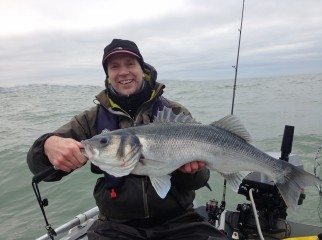
Pursuing big bass has long been the ambition of many bass anglers. Angling for bass is as popular as ever and still the double figure fish is the dream of many.
The value of bass angling and benefits it produces is as relevant today if not more so. Ireland reacted to its own bass issues and we now see the Isle of Man following a similar path. A healthy bass fishery must contain variety as well as quantity.
“There is a very big difference between what commercial fishermen see as sustainable exploitation compared to sea anglers. Commercial fishermen want abundant small fish; anglers want a more natural balance of different sizes of fish including bigger female fish, which produce the most eggs.”
Big female fish are far more than only a sporting challenge, they are an asset to the fishery, its continuation and genetics that can benefit all. These fish have also faced and survived all the problems or traps that nature and man has set before them and continued to add value to the wild stock gene pool, the anglers endeavour and brings many benefits.
“6. As bass mature and grow the number of eggs produced increases with body weight. Bigger female bass produce more viable eggs, which increases the buffering capacity for poor spawning years (see also negatives of a skewed age structure on fish stocks discussed in the Net benefits report in section 3.4.2 of the section ‘Stocks and the environment’).[NB – you will need to download a free copy of Acrobat Reader from the Adobe web site to read the pdf file].”
This video is quite an interesting insight into the striped bass fishery in America and how the massive industry is built on the foundation of recreational angling. It highlights the benefits to tackle trade, shops, hotels, guides etc all adding up to support local economies in areas which are often on the peripheries of the country. Touching upon the economic factors such as more jobs, more wages and raising more taxes etc.
“’Managing striped bass so that they generate the highest economic value from a common property resource and one that benefits the highest number of users .. and simply put that is game fish for striped bass..”
We hear some insights as well from people, such as guides, who make living from the striped bass and some fear that in the future they will have no job.
In recent years, the focus regarding bass conservation has been focused on increasing the minimum landing size (MLS)(MCRS)however, what about the larger, mature breeding stock? The video touches upon the impact of killing these large, breeding females can have and how it can take its toll on stocks.
“The concept of game fish is not about taking commercial mortality and turning it into recreational mortality … the concept of making the fish a game fish is to change the values for which the fishery is managed to one of just consumption to one of utilizing it as a recreational resource.”
This is where a slot size comes into play to protect those important fish at both ends of the scale … it is important that we do not solely focus on juvenile fish but also those mature fish which we sadly too often see being help up as ‘trophies’ …
I think it is staggering to hear and see the brief section of charts, graphs and research that shows striped bass are worth 20 times more per lb if left alive than being killed commercially. It is these socio-economic studies (similar was done in Ireland) which can help strengthen the RSA case for further commercial restrictions.
“Fishermen are poor farmers … they don’t let the field lay fallow they just keep catching until they are all gone or until some forces them to stop catching…”
Maybe there are a few lessons to be learnt here or at least some thoughts and concepts to take away and play around with regards our own bass management policies in the years to come.
Have something to say? Click Here.
Further reading-
BOFFFFs: on the importance of conserving old-growth age structure in fishery populations
Let the big fish go to save the species
[Bass Blog by Les G and Steven Neely ]
SOS Bass Click Here
.Contact Us info@saveourseabass.org
B.A.S.S http://www.ukbass.com/about/